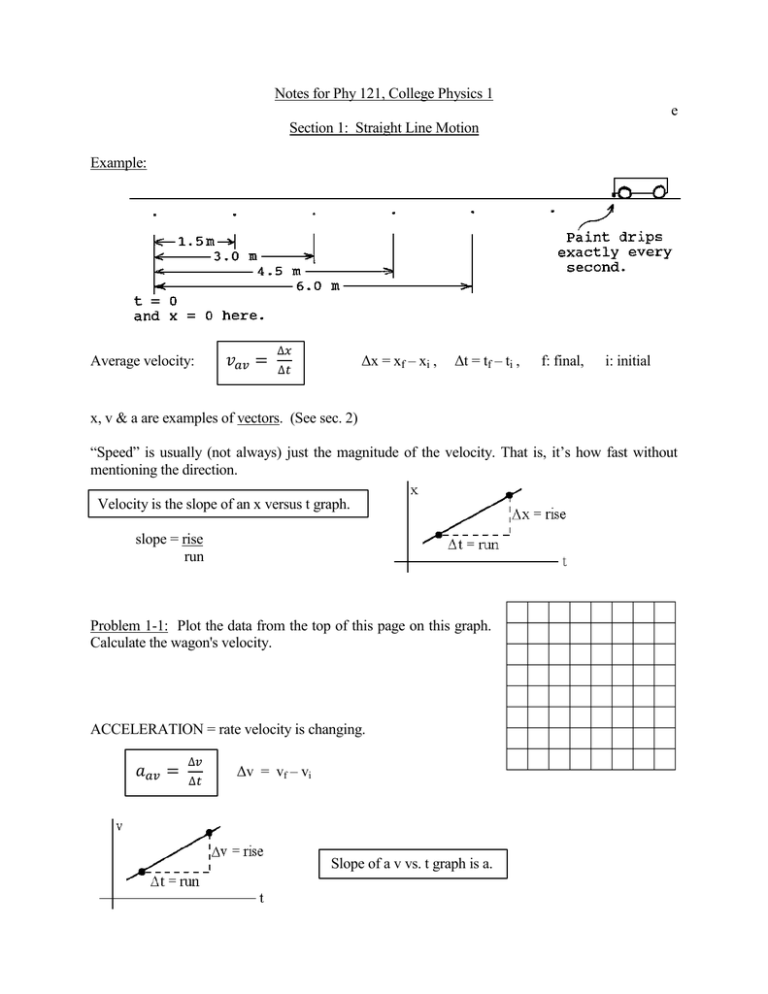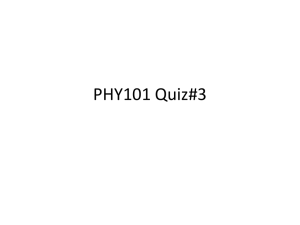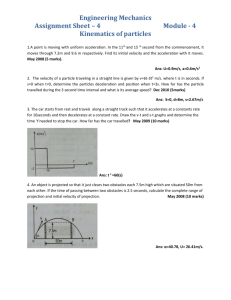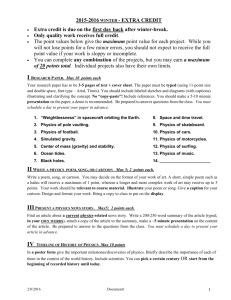Document 11695694
advertisement

Notes for Phy 121, College Physics 1 e Section 1: Straight Line Motion Example: Δx = xf – xi , Average velocity: Δt = tf – ti , f: final, i: initial x, v & a are examples of vectors. (See sec. 2) “Speed” is usually (not always) just the magnitude of the velocity. That is, it’s how fast without mentioning the direction. Velocity is the slope of an x versus t graph. slope = rise run Problem 1-1: Plot the data from the top of this page on this graph. Calculate the wagon's velocity. ACCELERATION = rate velocity is changing. Δv = vf – vi Slope of a v vs. t graph is a. - 2Problem 1-2: What is the wagon's acceleration? (It’s better to do this in a notebook rather than on this handout. There’s more room, and if you do it again later for practice, you can read the question without having to see the solution.) Example 1-a: Find this stone's acceleration: (Taking notes yourself, as opposed to receiving printed ones, focuses your attention on what you’re writing. You don’t need to learn the question, so I printed that. But I saved the solution for the board.) Acceleration due to gravity: All freely falling objects (no air friction) accelerate at g = 9.8 m/s2 = 32.2 ft/s2 Uniformly accelerated motion: Manipulate these definitions, and build in assumption that a is constant (v increases steadily) to obtain 5 equations on formula sheet. Example 1-b: You drop a rock off a cliff and see it hit bottom 5.0 sec later. How high is the cliff? Ans: 122 m Example 1-c: A rocket maintains an acceleration of 25 m/s2 for two minutes. What is its final speed if it started from rest? Ans: 3000 m/s To convert units: Multiply by a fraction where numerator equals denominator, set up so unwanted unit cancels out. Problem 1-3: Using conversion factors from your formula sheet, convert 50 miles per hour into meters per minute. Ans: 1340 m/min Note: Direction of x, v or a is indicated by whether they are positive or negative. Note: These signs are independent of each other. - 3- Example: Throw a ball straight up: Also note: Do not confuse instantaneous velocity at start or end, vi or vf, with the average velocity for the whole time period, vav. Problem 1-4: A certain airplane accelerates at 1.25 m/s2, and leaves the ground when going 30 m/s. What is the shortest runway it can use, starting from rest? Ans: 360 m Problem 1-5: You throw a rock straight up at 15 m/s. How long until it hits you on the head? Ans: 3.06 s - 4Significant Figures: I used to try to cover this, but eventually decided there wasn't room in the course. All I expect now is that you won’t round too far from the correct answer. For example, don't round 3.46 to 3. If you are more than 2% from the correct answer on a test, I will treat it like an arithmetic error. Otherwise, I will treat incorrect rounding like incorrect spelling. Writing "fizzyx" for the name of this course won’t cost you credit either. But if you prefer not to look quite that ignorant, here is how you ought to round your numbers: The basic idea is not to mislead your reader about your accuracy with more decimal places than you actually know. For example, say you measured the width of a piece of paper as 8.0 + .3 cm. If you then calculate one third of that, your calculator tells you 8.0/3 = 2.666666667. But, using the rules for experimental uncertainty from lab 1A, this is only accurate to + .1 cm. So, most of those figures, or digits, are meaningless. The 7 on the end, for example, might in fact be a 3 or a 9 or anything. The significant figures are the ones about which you have some information. The last of those would be the first 6, because based on the + .1 it might really be a 5 or a 7, but at least you know it isn't anything else. So, usually you should round after the decimal place which is somewhat, but not completely, uncertain: 2.7 + .1 cm. When you don't calculate an uncertainty, round using the idea that the answer can't be any more accurate than the least accurate number that went into it. However, exactly how you define "accuracy" depends on what operation you are performing: If adding or subtracting: Round to the same number of DECIMAL PLACES as the number with the fewest. Example: 1234.5 + 6.78 = 1241.3 6.78 goes to the hundredths place, but 1234.5 only goes to the tenths place. Round 1241.28 on your calculator to 1241.3. The reason: You don't know what is in the hundredths place of 1234.5, so you don't know what to add to the 8, so you don't know the hundredths place of the answer. If multiplying or dividing: Round to the same number of SIGNIFICANT FIGURES as the number with the fewest. Example: (1234.5)(6.78) = 8370 1234.5 has five significant figures, but 6.78 has only three. Round 8369.91 on your calculator to 8370. (Or, in a case like this, the number of significant figures is clearer if written as 8.37 x 103.) The reason: Let ? stand for a figure you don’t know. (1234.5)(6.78?) = (1234.5)(6) + (1234.5)(.7) + (1234.5)(.08) + (1234.5)(.00?). (1234.5)(.00?) might be as big as (1234.5)(.009) ≈ 11 or as small as (1234.5)(.000) = 0. Since you are adding in something that could be anywhere between 0 and 11, you have no idea what’s in the last place before the decimal. Other operations: Rounding by the number of significant figures, like when multiplying, is usually ok. A couple of final notes: - Unless specifically told otherwise, assume that all numbers given by the text or me are good to three significant figures. (If I write 7, I'm being lazy and really mean 7.00.) - When solving a problem involves several steps, wait until the end to round. If you keep rounding along the way, it sometimes adds up to a considerable difference in the answer. - 5Section 2: Vectors: have magnitude and direction. Examples: force, velocity … Scalars: have only a magnitude. Examples: number of atoms in an object, temperature … VECTOR ADDITION (Finding a vector which is equivalent to several acting together): On a scale drawing (head-to-tail method): Draw an arrow for each vector, with its tail on the head of the one you drew before it. Then, draw the resultant from the tail of the first to the head of the last. Example: Walk 50 ft. horizontally, then 20 ft on a 35 ramp, then climb 30 ft up a rope. What is your resultant displacement? (Displacement = direction and distance from some reference point.) Answer: scale: 10 feet = 1 centimeter Draw first vector: Then, the next from the tip of the first: Then, the next: - 6Then, the resultant from the tail of the first to the head of the last: Measure resultant's length with a ruler and angle with a protractor: Answer: 78 ft at 32 NOTICE: Complete answer includes: 1. Both magnitude and direction, 2. Correct units. Problem 2-1: Two people push on a table as shown. Find the resultant of these forces. (1 newton = .225 lb) Ans: 18 N at 34° To calculate resultant (instead of measuring a scale drawing): MATH REVIEW: - 7Components: A vector can be thought of as the sum of two other vectors, one parallel to each axis, called its components. Example 2-a: Find the x and y components: Ans: 17.3 m, 10.0 m Example 2-b: Find the magnitude and direction of the vector with these components: x = 10.0 lb, y = 5.00 lb. Ans: 11.2 lb at 26.6° Problem 2-2: Find the resultant mathematically: Ans: 17.5 lb at 31° Problem 2-3: Find the x and y components. Ans: 44.1 N, 60.7 N Projectiles (with no air friction): This is just the superposition of two one dimensional motions: Think of a ball flying across a dark room, with a spotlight behind it, and a spotlight above it. The shadow on the floor represents the x components of its motion; the shadow on the wall represents the y components. The x component has a constant velocity. (ax = 0.) y has a constant acceleration. (ay = -g, if down is negative.) These kinds of one-dimensional motion are described by the equations from section 1. Example 2-c: A ball is thrown at 23 m/s, 37 above the horizontal. If it lands at the same height it was thrown from, how far away does it land? Ans: 51.9 m - 8Problem 2-4: The cannonball is fired horizontally at 100 m/s. a. Fill in the table: x y displacement ⃑⃑⃑ b. How far from the base of the cliff does it hit the water? Ans: 495 m Problem 2-5: With what speed (magnitude of Ans: 111 m/s ) does it hit the water? Example: The "Paris gun" used by the Germans in 1918 had a muzzle velocity of 1600 m/s. If fired in a vacuum at 45, to what maximum height would the shell rise? Ans: given: viy = 1600 sin45 = 1131 m/s, vfy = 0, ay = -9.8 m/s2 find: Δy 2 2 vfy = viy + 2 ay Δy 2 2 0 = 1131 + 2(-9.8)Δy 6 1.28 x 10 = 19.6Δy 6 4 Δy = 1.28 x 10 / 19.6 = 6.53 x 10 m (40.6 miles) Problem 2-6: A football is kicked at 15.0 m/s, 30 above the horizontal. Assume it reaches its maximum height just as it gets to the goal, and that the crossbar is 3.05 m (10.0 ft) from the ground. a. Does the ball go over or under the bar? b. What is its speed at this time? Ans: under (2.87 m from ground), 13.0 m/s - 9Section 3: Newton's Second Law, Vector Addition 2nd Law: ⃑ ⃑ ⃑ = net force on object ⃑ = acceleration m = mass = "amount of matter" in the object = a measure of its inertia. A special case of that: If 1st Law: ⃑ = 0, then ⃑ must = 0: In the absence of a net force, is constant. Example: Objects with no force to keep them moving (like you) don’t get left behind as Earth orbits the sun: You keep moving just because you’re already moving. Units: The meter, kilogram and second are each defined by some standard or experiment. (Example: 1 m = the distance light travels in a certain amount of time.) All other units used in mechanics are derived from those. 2 From F = ma, 1 N = 1 kgm/s . (So, to get the units to work right in a calculation, grams must be converted to kg, cm into m, etc.) Be sure not to mix up units of force (N) with units of mass (kg). Use formula sheet if unsure. Problem 3-1: In each case, state what the unit is in terms of the fundamental units m, kg and s. 2 (Example: 1 N = 1 kgm/s ) a. Kinetic energy is measured in joules, and its formula is KE = 1/2 mv2, where m is mass and v is velocity. b. Power is measured in watts, and a formula for it is P = Fv, where F is force and v is velocity. Mass & Weight: Mass = amount of matter in an object. Weight = the force of gravity on an object. From F = ma, Example: Find the weight of a 1 kg mass (on earth). Answer: W = mg = (1 kg)(9.8 m/s2) = 9.8 N - 10Vector Addition, Component Method: The sum of several vectors equals the sum of their components. So, 1. Resolve all vectors into x & y components. 2. Sum the x components, and sum the y components. Pay attention to signs. 3. You now have the x & y components of the resultant. (Draw sketches to keep track of what's going on.) Example 3-a: Find the net force on the object. Ans: 165 N at 117° Problem 3-2: Find the resultant of these two displacement vectors: 150 m at 26 and 115 m at 242. (Give the resultant's magnitude and direction.) Ans: 88.4 m at -23.9° Solving problems using ⃑ ⃑: ΣFx = max ΣFy = may Example: Two 100 N balls are suspended from a system of ropes, as shown. Find the tension in ropes 1 and 2. (The force the rope pulls with at its ends.) Procedure for solution: 1. Free - body diagram: Shows just the object you will apply the equations to, and all forces acting on it. - 112. Find the components of each force. 3. Set up and solve equations: ΣFx = 0 - T1 + T2 cos 53° = 0 ΣFy = 0 T2 sin 53° - 100 = 0 (Every horizontal arrow on diagram becomes a term in ΣFx. Every vertical arrow on diagram becomes a term in ΣFy.) THE EQUATIONS COME FROM THE DIAGRAM: IF YOU SKIP THE DIAGRAM, YOU CAN’T GET THE RIGHT EQUATIONS. T2 sin 53 = 100 T2 = 100 sin 53 T2 = 125 N -T1 + (125) cos 53 = 0 125 cos 53 = T1 T1 = 75.2 N Problem 3-3: Make a sketch showing all forces on Wiley Coyote a. while being struck by a bus. (At this instant, he is in contact with the ground, and not yet in motion.) b. sliding across level ground, after bouncing off the bus. c. just after sliding off a cliff. (Freely falling.) Problem 3-4: A climber rappels from a vertical cliff as shown. If she weighs 600 N and the forces on her feet are horizontal, how large is the tension in the rope? Ans: 613 N - 12Problem 3-5: The tension in the rope is the same from one end to the other. The tightrope walker on the right weighs 700 N. How large is the tension in the rope? (There is an unknown friction force which is approximately horizontal.) Ans: 3.66 kN - 13Section 4: More F = ma. Friction. Problem 4-1: A 1000 kg car involved in an accident left skid marks 90 m long. Friction would have been 8000 N. Was it initially traveling at a legal rate of speed? (55 mph = 24.6 m/s) Ans: No. (37.9 m/s) For a system of objects, write more than one F = ma equation. (Apply F = ma to the system as a whole, or to any part of it.) Problem 4-2: The blocks accelerate downward at 2.00 m/s2. Find the tension in both ropes. Ans: A: 39.0 N, B: 23.4 N Friction: fs = force of static friction. (fmax when about to slip. Force is often less than this; whatever is needed to maintain equilibrium.) fk = force of kinetic (sliding) friction. (fk < fmax) fmax & fk depend on: the NORMAL FORCE, n = force to surfaces which is pushing them together. the COEFFICIENT OF FRICTION, μ Greek "mu" = a property of the materials (table in handout). fs μsn Direction: Friction always opposes motion. fk = μkn - 14- Problem 4-3: a. If block is at rest, and P = 10 N what is f? b. What must P be to start it moving? c. What must P be to keep it moving (at constant speed)? Example 4-a: A 5.0 kg block is pulled by a rope at 40 above the horizontal. If the rope pulls with 35 N and the coefficient of kinetic friction is .57, what is the acceleration? Ans: 2.34 m/s2 Problem 4-4: Find the acceleration of the block, if the rope is pulled with a 50 N force. (μk = .400) Ans: 1.46 m/s2 - 15Review of Sections 1 - 4: My exams have five parts, each worth 25 points. The best four you do will be counted. So, it’s best to do all five, and let me drop the worst one. How to study: Be on intimate terms with your notes. Understand the concepts and how to apply them. Review the sample problems. If you’ve kept up with the weekly work, just going through the notes to refresh your memory and fill in any gaps is probably all you need. If you haven’t been keeping up, you should still focus on the notes, especially on solving problems. If it turns out you can’t learn a month of material in one night, do more each week in the future. Don’t just memorize quiz solutions without getting a feel for the concepts. If necessary, use Mastering Physics and/or work more problems from the text in areas where you feel weak. As always, you can come to my office for help. The questions below are not so much a review for the test as one more look at some points I think the class might need help with. Don’t expect the actual test questions to be similar; you need to study everything we covered. 1. A ball weighing 45 N is hanging from a string. A horizontal force of 20 N pulls it to one side. a. What is the x component of the string tension? b. What is the y component of the string tension? c. What angle does the string make with the vertical? Ans: (c) 24° 2. The tip of a robot arm is moving to the right at 8.0 m/s. After it has gone 30 cm, its velocity is then 2.0 m/s. What was its acceleration? Ans: -100 m/s2 3. A ball thrown at 24.0 m/s reaches its maximum height after 1.37 seconds. At what angle from the horizontal was it thrown? Ans: 34° 4. The rope is pulled with a force of 19.0 N, 35° above the horizontal. Find the acceleration of the 5.00 kg block. Ans: 1.71 m/s2 5. Short answer, 5 points each: a. In terms of the three fundamental units; the meter, the kilogram, and the second, what is a 3 2 newton? (I'm looking for 1 N = 1 skg /m , or something like that.) b. At what point along the flight of a projectile is its acceleration greatest? - 16c. As string A unwinds from the wheel, the boxes have a downward acceleration. Multiple choice: The tension in string B is a. less than 2 N. b. equal to 2 N. c. between 2 N and 3 N. d. equal to 3 N. e. between 3 N and 5 N. f. equal to 5 N. g. more than 5 N. d. The direction of a certain vector is θ = - 40. Is its x component positive or negative? e. The graph shows position as a function of time for three different objects, A, B and C. Which is going fastest, or are their speeds the same?







